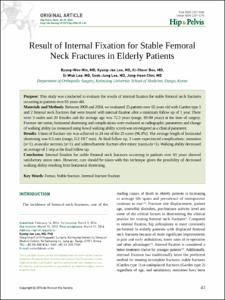KUMEL Repository
1. Journal Papers (연구논문)
1. School of Medicine (의과대학)
Dept. of Orthopedic Surgery (정형외과학)
Result of Internal Fixation for Stable Femoral Neck Fractures in Elderly Patients
- Keimyung Author(s)
- Min, Byung Woo; Lee, Kyung Jae; Bae, Ki Cheor; Lee, Si Wook
- Department
- Dept. of Orthopedic Surgery (정형외과학)
- Journal Title
- Hip & Pelvis
- Issued Date
- 2016
- Volume
- 28
- Issue
- 1
- Keyword
- Femur; Stable fracture; Internal fracture fixation
- Abstract
- Purpose: This study was conducted to evaluate the results of internal fixation for stable femoral neck fractures
occurring in patients over 65 years old.
Materials and Methods: Between 2008 and 2014, we evaluated 25 patients over 65 years old with Garden type 1
and 2 femoral neck fractures that were treated with internal fixation after a minimum follow up of 1 year. There
were 5 males and 20 females and the average age was 72.3 years (range, 65-84 years) at the time of surgery.
Fracture site union, horizontal shortening and complications were evaluated as radiographic parameters and change
of walking ability (as measured using Koval walking ability score) was investigated as a clinical parameter.
Results: Union of fracture site was achieved in 24 out of the 25 cases (96.0%). The average length of horizontal
shortening was 6.5 mm (range, 0.2-19.7 mm). At final follow up, 3 cases experienced complications: nonunion
(n=1), avascular necrosis (n=1), and subtrochanteric fracture after minor trauma (n=1). Walking ability decreased
an average of 1 step at the final follow up.
Conclusion: Internal fixation for stable femoral neck fractures occurring in patients over 65 years showed
satisfactory union rates. However, care should be taken with this technique given the possibility of decreased
walking ability resulting from horizontal shortening.
- Publisher
- School of Medicine
- Citation
- Byung-Woo Min et al. (2016). Result of Internal Fixation for Stable Femoral Neck Fractures in Elderly Patients. Hip & Pelvis, 28(1), 43–48. doi: 10.5371/hp.2016.28.1.43
- Type
- Article
- ISSN
- 2287-3260
- Appears in Collections:
- 1. School of Medicine (의과대학) > Dept. of Orthopedic Surgery (정형외과학)
- 파일 목록
-
-
Download
 oak-2016-0215.pdf
기타 데이터 / 471.21 kB / Adobe PDF
oak-2016-0215.pdf
기타 데이터 / 471.21 kB / Adobe PDF
-
Items in Repository are protected by copyright, with all rights reserved, unless otherwise indicated.